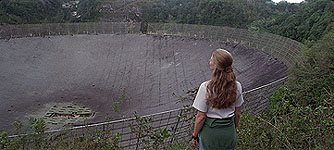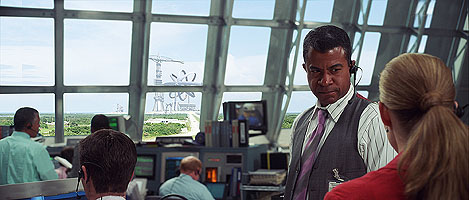
Directed by Robert Zemeckis
Visual Effects Supervisor: Ken Ralston

Directed by Robert Zemeckis
Visual Effects Supervisor: Ken Ralston
WETA LTD. [48 shots]
Nominated for five 1997 VFX HQ Awards: Best Visual Effects, Best Sequence (The Ride), Best Shot (Powers of Ten), Best Invisible Effects (Dish Restoration) and Best Compositing.
Just as I began to lose faith in Hollywood, believing that it is no longer possible for Hollywood to produce an excellent film with some fine visual effects, Robert Zemeckis opens up his bag of tricks. He is one of America's finest filmmakers, and one who understands how to use the best visual effects to support a strong story and characters. CONTACT is simply the best visual effects film in a long time, probably the best since Zemeckis' own FORREST GUMP of 1994.
The effects were supervised by Zemeckis' longtime collaborator, Ken Ralston, who has won Academy Awards working on Zemeckis' films WHO FRAMED ROGER RABBIT, DEATH BECOMES HER and FORREST GUMP. The bulk of the effects were handled by Sony Pictures Imageworks (where Ken Ralston is the president), and numerous other scenes and shots were handed off to such houses as Weta Ltd. in New Zealand, Industrial Light & Magic, Warner Digital Studios, and others.
 Visual Effects Produced by:
Visual Effects Produced by:
SONY PICTURES IMAGEWORKS [300 shots]
SPI Supervisor: Stephen Rosenbaum
INDUSTRIAL LIGHT & MAGIC [40 shots]
WARNER DIGITAL STUDIOS
CIS HOLLYWOOD
FOUNDATION IMAGING
PACIFIC OCEAN POST
MAC-GUFF
THUNDERSTONE
BIG SKY POST
Review by Todd Vaziri
![]()
Download the CONTACT Quicktime
Director Robert Zemeckis, actress Jodie Foster and VFX supervisor Ken Ralston at the bluescreen shoot for CONTACT. ~4.6MB. ©1997 Warner Bros.
      Still frames from the film's opening shot. Nominated for Best Shot in the 1997 VFX HQ Awards, the stunning shot created by Sony Pictures Imageworks is a masterpiece, reportedly the longest single digital effects shot ever created. |
The film opens where MEN IN BLACK ended, in a way. MIB concluded with a dramatic pullback from a New York street to the Milky Way (executed by ILM), while CONTACT enjoys a similar sequence. Beginning with the Earth, the camera slowly pulls back to reveal the moon, the rest of the solar system, various layers of nebula and stellar debris, to reveal the Milky Way. The shot continues deeper into space revealing hundreds of other galaxies... finally revealing that the light from all of these stars was actually the highlight of a young girl's eye. The sequence, produced by Sony Pictures Imageworks (SPI) contains some very nice CGI animation. Especially nice were Saturn's rings, as well as some of the nebula and asteroid formations.
The first half of the film contains a number of invisible effects--effects that give the filmmakers more freedom and enhance the picture, instead of being the focus of a shot.

The top image is a frame from the original photography; Jodie Foster reaching the Arecibo radio dish, in its present, actual state. Although the dish is in reality fully functional, visually it appears old and ragged. CIS Hollywood performed some digital magic on the dish, replacing the rotting bowl with a digital matte painting of a crisp, clean dish (seen below), and performed extensive rotoscoping and color correction to make the shot come alive with color. For more info on this shot, visit CIS' web site.
|
A number of day-for-night shots were handled by ILM, as well as a bunch of sky-replacement shots. The entire nighttime sequence of Ellie driving to the VLA after she hears the alien transmission was shot in the daytime. In addition, many of the New Mexico VLA shots contained digital matte paintings as sky backgrounds and CG animated dishes, in static shots as well as dolly shots and hand-held tracking shots.

Although the production utilized a translight for some control room shots to depict the Machine on the other side of the windows, other shots were shot with a huge bluescreen behind the windows. The Machine animation, rendered by Sony Pictures Imageworks, was composited into the bluescreen footage by Warner Digital in these shots.
|
Various other invisible effects include some terrific composites by CIS Hollywood, who handled some sky replacement in nighttime shots (like the long, nighttime tilt-down to Ellie and Palmer looking at constellations), as well as a beautiful pullback from young Ellie's bedroom, where the camera goes outside her bedroom window and pulls back all the way outside the house. CIS also created a 100% invisible effect as it digitally replaced the Arecibo dish, replacing the dirty dish with a cleaned-up matte painting version, as well as enhancing the surrounding foliage and lighting. Warner Digital produced a share of invisible shots, as well, including some windshield reflections as Ellie is driven to the VLA after the news of the transmission breaks. WDS composited a reflection of a religious fanatic (Jake Busey) into Ellie's windshield.
Another brilliant and shocking invisible effect occurs as young Ellie's runs upstairs to get her father's medicine. The steadicam shot not only changes frame rates in the middle of the shot, slowing the action down, but the images captured from the camera change perspective. As she approaches the medicine cabinet, the view we had been seeing actually becomes a reflection as she opens the medicine cabinet door. Handled by SPI, it is probably the movies' most clever and stunning shot. SPI's invisible shots continue in such shots as Ellie meeting up with a jet on a runway on a rainy night. The scene was shot on Sony's stages with an enormous bluescreen which was later replaced with a digital matte painting of the airport at night.
A definite reminder of their wizardry in FORREST GUMP, Zemeckis and Ralston placed none other than Bill Clinton in a series of composites that were presented at video resolution. For one speech, Clinton was supposed to speak to the press in the White House press room. The best, one appropriate speech researchers found was Clinton discussing the possibility of life on Mars... in the Rose Garden. Clinton was meticulously extracted from the frame and composited into a background plate of the press room. Although they contain shadows that are inconsistent with an indoor lighting setup, the Clinton shots are fun to watch.
The message is understood, and The Machine is built. Dozens and dozens of video-resolution effects shots are featured in the second half of the film, depicting news footage of the event. Pacific Ocean Post handled a few of these shots, including compositing of the Cape Canaveral crowd shots and jet flybys. SPI handled many of these effects, producing them as standard effects shots, then adding video scan lines and video noise to make it look like the footage was shot on videotape.
The first Machine itself was primarily a CG creation, while the second Machine was mainly CG, with a few cuts to 1/24 scale miniatures. The Machines, 1500 foot tall monsters with rotating parts, a huge platform and moving mechanisms, look lovely on screen. When the camera is far from the Machine, which is usually is, the composites work quite well--appropriate mist and fog was added in front of the Machines to simulate depth. During a long conversation between Foster and Tom Skerrit, the Machine appears over Skerrit's shoulder, and is composited perfectly into the shots which were not locked down, and panned and tilted to match Skerrit's performance.
The film's effects continue as the first Machine is destroyed in a wonderful sequence of shots. The CGI machine is perfectly match moved into background plates, even as the camera whips around to follow the Machine's debris field.
On a stormy night, Ellie is escorted to the second Machine, located off the waters of Japan, and is brought there by Harrier onto a Haddon cruiser. On a dark, rainy night, her plane flies by the camera and lands on the ship. SPI's work on the single shot included highly believable interaction between the CGI boat and the water around it; the splashing between the ship and the water outshined ILM's similar work on SPEED 2.
However, this shot suffers from the same thing that hampers the realism of most complex synthetic shots--too much happens in a single shot. Perhaps if it were broken up into two shots, one where the harrier zips past the camera and another where the plane lands on the ship, people wouldn't have been so quickly cued that this was an effects shot. Instead, the audience gets the impression that these actions couldn't have possibly been shot, live, in one take, due to the complex nature of the actions; the illusion is lost. In addition to this shot, there is one other shot where the illusion is blown--once again, a miniature model harrier flies just a few feet over the camera, with the Machine in the background.
Ellie finally enters the pod and begins The Ride to Vega. For The Ride sequence, some 40 shots were delivered by Weta Ltd., the New Zealand effects house that created all the effects for last year's THE FRIGHTENERS, including a few produced by ILM. Many shots of the first wormhole were handled by Weta, as well as the foreground element of the pod--the over-the-shoulder pod-vision shots. Weta also contributed the shots of the floating compass and chair, both completely photorealistic CG creations.
The incredible four-minute sequence features hundreds of digital and practical elements, and the ride is well worth the wait. The Ride is at times scary, frenetic, violent, as well as beautiful, mystifying and awe-inspiring. The Ride ends as Ellie reaches the Vegan representative, meeting Ellie on a surreal beach environment. Backgrounds were created from a myriad of beach footage seamlessly tiled together, resulting in a 360 degree world where any camera angle could be represented. Foster and David Morse (portraying Ellie's father) were photographed in front of a bluescreen and composited into these shots. The art direction of this sequence is quite stunning--there are broad strokes of purple and blue in the sky, along with the shimmering blue/green sea. It's quite an eyefull. One problem with the sequence is that some of the camera moves seem a bit too stiff, although the sequence was shot without motion-control--SPI match-moved the backgrounds so that it matched with the camera movement.
CONTACT is a terrific film, and should not be missed in theatres. The invisible effects are brilliant, as are many of the money shots of the Machine and the Ride. Creating the visual effects was a team effort, led by Ralston's SPI, and contains some of the most innovative effects shots seen in a long, long time.
Check out American Cinematographer July '97 and Dec. '97.
Check out Cinefex 71.
Official Web Site: http://www.contact-themovie.com

. . VFX HQ Produced by Todd Vaziri . . http://www.vfxhq.com . . e-mail: tvaziri@gmail.com . .
All text Copyright © 1998 Todd Vaziri, unless otherwise noted